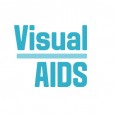
Shan Kelley, “With Curators Like These, Who Needs A Cure” (2015)
Adam Barbu is a writer and curator living in Toronto. He is pursuing his graduate studies at the University of Toronto. Recently, he was awarded the 2015 Middlebrook Prize for Young Canadian Curators. He curated the Visual AIDS web gallery The Circle Won’t Be Broken in May 2015, and we are thrilled to publish here his recent text “From Explication to Doubt: Curating HIV/AIDS Today.”
Today, there is no shortage of exhibitions focusing on the relationship between HIV/AIDS, late 20th century identity politics and queer artistic practice. However, this popular “cultural evidence” narrative often submits to the assumption of a linear and consistent AIDS experience, or, a set of necessary aesthetic and political truths that can be decoded through the sound, objective research of the curator-historian. A key question must be raised: How do we curate HIV/AIDS without submitting to problematic cultural essentialisms or the rhetoric of “post-everything” identity politics?
To address the challenges that this binary relation presents, it seems that our task as curators is to pursue a sense of positive differentiation that cannot be reduced to the additive logic of “queer representation,”and therefore, the didacticism of the “cultural evidence” narrative. This means exploring a language of difference that is not simply interested in authenticating the injurious effects of heterosexist and homophobic discourse through “holistic” sets of images that are presented to actually reflect society.1 Recently I have worked to address the above question through a set of exhibitions developed in part through research with Visual AIDS Artist Registry. A group exhibition titled A Minimal Doubt opened in July at Videofag in Toronto, and another, titled The Queer Feeling of Tomorrow, will open at the Art Gallery of Guelph (Guelph, Canada) in September. By tracing a shift in thinking from the explication of history to the precariousness of our collective futures, both of these projects focus on the politics of indecision as queer resistance.
A Minimal Doubt brought together three talented Canadian artists: Vincent Chevalier, Shan Kelley and Andrew McPhail. The program of nine works sought to highlight cross-sectional readings on poz status and aesthetic value, proposing a deferral of “self-knowledge” through queered forms of language and text. The title and working concept for the exhibition was used to express a tension embedded in the idea of “queer futurity.” When one states that doubt is minimal, it evokes a kind of implicit hope. And at the same time, the utterance of this term points to a kind of productive skepticism whereby the forces of inaction and obsolescence remain at the center of the discussion.
Further extending on these themes, The Queer Feeling of Tomorrow features work by a larger group of artists that includes Sunil Gupta, John Hanning, and a new selection of work from Kelley. The exhibition focuses on overlapping personal and political micro-histories, highlighting movements away from the urgent and the spectacular towards the unbalanced and the everyday. Similar to A Minimal Doubt, The Queer Feeling of Tomorrow highlights primarily text-based conceptual works that expresses a double play of optimism and skepticism. On the one hand, these works trace a kind of candid levity; on the other, they embody a kind of self-conscious facetiousness and harsh irony. This tension between perseverance and grief is perhaps nowhere better expressed than in John Hanning’s I Survived AIDS (2013), a series comprising seemingly innocent middle-school portraits cast upon a future of stigma and violence that the boy did not and could not know. Altogether, the exhibition constructs an amalgamation of precarious, obstructed documents, fragmented biographical notes, and emptied out quotations held in a flux of continuous de-contextualization and re-contextualization.
Furthermore, working in this spirit of double meaning, the two exhibitions seek to underscore a sense of absurdist self-reflexivity. For example, Chevalier’s text-based work “AIDS Art” (2015) features a cryptic, self-referential run-on sentence that attempts to describe the meaning and function of “AIDS art.” Chevalier does not attempt to arrive at a singular, coherent definition, but rather works to bring his subject into a deeper, more frustrating realm of ambiguity. Operating within a language of pure paradox, the work at once critiques, supports and performs the idea that “AIDS art is about AIDS art.” This self-reflexivity is elsewhere evident in Kelley’s “With Curators Like These, Who Needs a Cure” (2015), a 5x7-inch wood block covered with varnish, semen and a subtle application of pubic hair whose surface reads: “My AIDS Won’t Fit in Your Museum.” By indexing the intimate excesses of his body, he winks to viewers by offering a closed-circuited dead upon arrival “queer authenticity.” Kelley points to the complexities and contradictions of everyday life that cannot be reduced to the museological invention of “AIDS art.”
Overall, each of the five artists displaces the expectation of a confessing, honest AIDS subject, one who knows his/her self, remembers his/her past and thereby defines his/her mark on the future. By underlining a set of relations that are out of sync with the rhythms of rationalist, liberal social progress, this displacement of expectation directly implicates the idea of queer temporality. One might define this as a sensibility of “bad timing” that occurs within a radically fragmentary and inconsistent formal language: circular word-babble, unfinished sentences, abandoned signs, precarious historical revisions and so on.
Of course, these discrete research interests are not meant to obscure the necessity for new models of HIV/AIDS awareness and related forms of political action. Rather, this shift in thinking, from explication to doubt, allows us to reconsider what resistance and activism means today.
1Susanne Luhmann, “Queering/Querying Pedagogy? Or, Pedagogy Is a Pretty Queer Thing” in Queer Theory in Education, ed. William F. Pinar. (Mahawah: Lawrence Erlbaum Associates, Inc., 1998), 143.








Comments
Comments